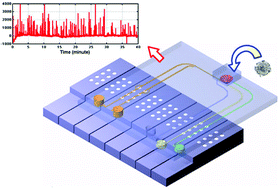Small volume low mechanical stress cytometry using computer-controlled Braille display microfluidics†
Abstract
This paper describes a micro flow cytometer system designed for efficient and non-damaging analysis of samples with small numbers of precious cells. The system utilizes actuation of Braille-display pins for micro-scale fluid manipulation and a fluorescence microscope with a CCD camera for optical detection. The microfluidic chip is fully disposable and is composed of a polydimethylsiloxane (PDMS) slab with microchannel features sealed against a thin deformable PDMS membrane. The channels are designed with diffusers to alleviate pulsatile flow behaviors inherent in pin actuator-based peristaltic pumping schemes to maximize hydrodynamic focusing of samples with minimal disturbances in the laminar streams within the channel. A funnel connected to the microfluidic channel is designed for efficient loading of samples with small number of cells and is also positioned on the chip to prevent physical damages of the samples by the squeezing actions of Braille pins during actuation. The sample loading scheme was characterized by both computational fluidic dynamics (CFD) simulation and experimental observation. A fluorescein solution was first used for flow field investigation, followed by use of fluorescence beads with known relative intensities for optical detection performance calibration. Murine myoblast cells (C2C12) were exploited to investigate cell viability for the sample loading scheme of the device. Furthermore, human promyelocytic leukemia (HL60) cells stained by hypotonic DNA staining


 Please wait while we load your content...
Please wait while we load your content...